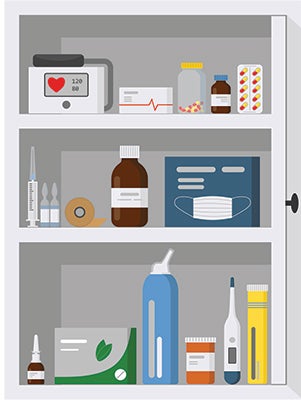Medication Safety
Did you know 4 out of 5 American adults take at least one medication?
Medicines treat diseases and relieve symptoms. Medicines are usually safe when taken as prescribed by a health care professional or as directed on the label, but there are risks in taking any medicine.
Adverse Drug Events
 Medicines treat diseases and relieve symptoms. Medicines are usually safe when taken as prescribed by a health care professional or as directed on the label, but there are risks in taking any medicine.
Medicines treat diseases and relieve symptoms. Medicines are usually safe when taken as prescribed by a health care professional or as directed on the label, but there are risks in taking any medicine.
An adverse drug event is harm resulting from the use of medication and includes allergic reactions, side effects, overmedication and medication errors. Adverse drug events are a serious public health problem and lead to more than 1 million Emergency Department visits each year.
Reduce the risk of harm from adverse drug events in adults:
- Keep a list of your medicines.
- Follow directions.
- Ask questions.
- Keep up with any blood testing recommended by your doctor.
- Take all medications only as directed.
New Medications
The National Institutes of Health recommends asking your doctor or medical provider the following questions when being prescribed a new medication:
- What is the name of the medicine and why am I taking it?
- What medical condition does this medicine treat?
- How many times a day should I take it? At what time? For example, if the bottle says take “4 times a day,” does that mean 4 times in 24 hours or 4 times during the daytime?
- How much medicine should I take?
- Should I take the medicine with food or not? Is there anything I should not eat or drink when taking this medicine?
- How long will it take this medicine to work?
- Will this medicine cause problems if I am taking other medicines?
- Is it safe for me to drive while talking this medication?
- What does “as needed” mean?
- When should I stop taking the medicine?
- If I forget to take my medicine, what should I do?
- What side effects can I expect? What should I do if have a problems?
- Will I need a refill? How do I arrange that?
Each time you visit your doctor, tell him or her about new medicines you're taking, and be sure to ask if you still need to be on all your medication.
Children & Medication
- Keep medications in their original packaging with child-resistant containers.
- Keep your medications out of sight (in a cabinet) and out of the reach of young children.
- Check expiration dates.
- Safely dispose of medicines. Do not flush.
- Do not use household spoons to give medicines. Spoons come in all shapes and sizes. Using a tablespoon instead of a teaspoon can mean 3 times too much medicine for your child.
- Use the oral syringe or dosing cup that comes with your liquid medicine to make sure your child gets the right amount.
- Ask your pharmacist if you don’t have one.
Overdoses
A special kind of adverse event is called an overdose.
An overdose occurs when a drug or a combination of drugs reaches a toxic amount and begins to overwhelm the body. While people can overdose from any drug or substance, opioid overdoses remain the most common and the deadliest. Opioids include buprenorphine (suboxone), dextromethorphan, fentanyl, hydrocodone, oxycodone, meperidine, methadone, tramadol and prescriptions, such as oxycontin, morphine, vicodin and percocet.
Overdoses can occur when a patient deliberately or accidentally misuses a prescription; uses an illicit opioid, such as heroin; or uses an opioid with other sedatives like alcohol. Stimulant overdoses, while more uncommon, can also be dangerous — leading to seizure, stroke, heart attack or death.
Opioids also fit into receptors in the body that affect the drive to breathe. Within minutes to hours, an opioid overdose will lead to unconsciousness, coma and then death.
Know Who is at Risk
- Individuals with recent abstinence, such as release from incarceration, discharge from hospitalization or medically supervised withdrawal or abstinence in treatment
- Prescription opioid users
- Individuals with co-occurring pulmonary/lung disease such as sleep apnea or emphysema
- Individuals with heavy alcohol use
- Individuals taking or prescribed other sedative (benzodiazepines) or antidepressant medication
If you suspect a person has overdosed, attempt to arouse with a firm rub to the center of the chest on the breastbone. If no response, administer naloxone (if available), call EMS and perform rescue breathing and CPR if no pulse. Stay with the patient for at least 3 hours or until help arrives.
Some resources for you to explore:
- Wake County Health & Human Services: Naloxone kits available while supplies last. 10 Sunnybrook Road, Raleigh, NC.
- Learn 2 Cope is for families with loved ones who have a substance use disorder
- CDC Medication Safety Program
- Wake Country Medication Drop Box Locations
Save the Poison Help number (800-222-1222) in all of your phones, including cell phones, so you have it when you need it — and make sure it’s available for your child’s babysitter or caregiver.
Information adapted from the National Institutes of Health and the US Centers for Disease Control and Prevention
RECOGNIZE AN OVERDOSE
Almost always, there is time to intervene between when the overdose starts and when the victim succumbs to the overdose. Learn to recognize the signs:
- Nonresponsive to outside stimulus
- Slow and shallow breathing
- Blue cast to fingernails or tips to lighter skinned people
- Grayish or ashen skin to darker skinned people
- Falling asleep spontaneously (nodding off) or losing consciousness
- Limp body
- Vomiting
- Slow, erratic or absent pulse
- Altered mental status or confusion different from previous intoxications